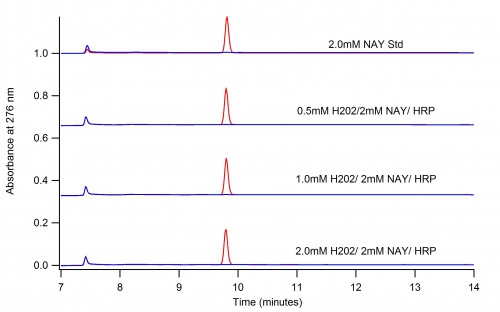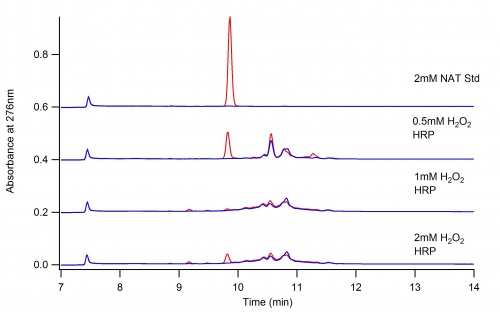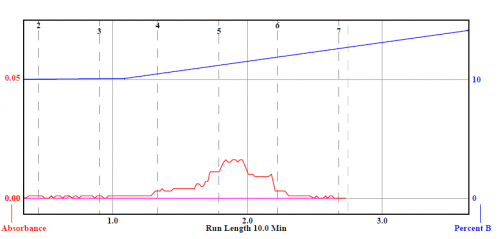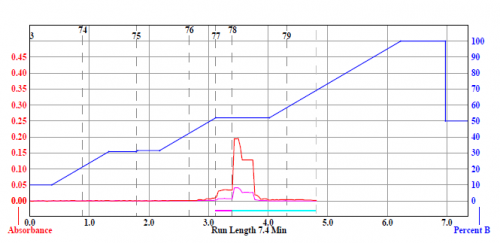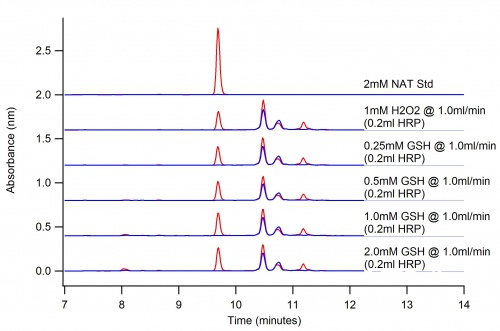Difference between revisions of "N-Acetyl L-Tyrosine"
Benstillwell (talk | contribs) |
Benstillwell (talk | contribs) |
||
| (95 intermediate revisions by the same user not shown) | |||
| Line 1: | Line 1: | ||
| − | [[File: | + | This page depicts the oxidation of N-Acetyl L-Tyrosine (NAT) by Horse Radish Peroxidase (HRP). Each sample of NAT was dissolved in pH 5 phosphate citrate buffer. The method used on the HPLC was "HPA_0604156". |
| + | [[File:NAT.png|200px|thumb|none|NAT]] | ||
| − | [[File:NAY_trial_-3_6-6-2016.jpg| | + | ==The Dioxane Conundrum== |
| + | The following two graphs depict the difference in reaction when dioxane is present and when it is not. The conclusion is that dioxane quenches the oxidation of NAT. | ||
| + | [[File:NAY_trial_-3_6-6-2016.jpg|500px|thumb|none|Figure 1: NAT oxidation in solution with dioxane and reacted with H2O2 and HRP 6/5/16. This graph shows the dioxane in the solution inhibiting the reaction completely. ]] | ||
| + | [[file:NATw-oDioxane.jpg|500px|thumb|none|Figure 2: 2mM NAT oxidation without dioxane and reacted with 2mM H2O2 and HRP in a beaker 6/5/16]] | ||
| − | [[ | + | |
| + | |||
| + | ==Beaker Reaction vs. Immobilized Enzyme Bio-Reactor== | ||
| + | The following graphs depict the difference in HPLC data when the reaction is conducted in a beaker and when the reaction is ran using the immobilized enzyme technique using a bio-reactor. | ||
| + | |||
| + | [[file:NATw-oDioxane.jpg|500px|thumb|none|Figure 2: 2mM NAT reacted with 2mM H2O2 and HRP in a beaker 6/5/16]] | ||
| + | |||
| + | [[File:IE69.jpg|500px|thumb|none|Figure 3: 2mM NAT reacted with 1mM H2O2 using the [[Enzyme Immobilization|Immobilized Enzyme]] technique 6/9/16]] | ||
| + | |||
| + | ==Concentration Test== | ||
| + | |||
| + | These graphs depict the difference in concentration of NAT and H2O2. Increasing the concentration will help to obtain more products. | ||
| + | [[File:KD 12.jpg|500px|thumb|none|Figure 4: 2mM NAT oxidation without dioxane and reacted with 0.5mM, 1.0mM, and 2.0mM H2O2 with immobilized HRP at 0.5ml/min 6/29/16]] | ||
| + | |||
| + | [[File:KD9.jpg|500px|thumb|none|Figure 5: 10mM NAT oxidized with 5, 10, and 20mM H2O2 with immobilized HRP at 0.5ml/min 6/23/16]] | ||
| + | |||
| + | ==Flash Chromatography== | ||
| + | |||
| + | The objective of flash chromatography is to isolate peaks seen in the HPLC. Running flash chromatography allows for the product to be isolated. | ||
| + | [[File:DK 11.jpg|500px|thumb|none|Figure 6: Flash chromatography separation of the 10mM H2O2 in Figure 5 6/28/16]] | ||
| + | |||
| + | |||
| + | |||
| + | The following graphs show the difference between running the flash system under conditions with wavelength at 276 and 300 with 223 and 276. The first graph is the NAT standard ran through the HPLC. The two flash chromatography graphs show the difference in changing the methods of the flash system. | ||
| + | [[File:NAT223.jpg|500px|thumb|none|HPLC chromatogram of 20mM NAT.]] | ||
| + | |||
| + | [[File:FLASHa.PNG|500px|thumb|none|Flash Figure 1: 20mM NAT ran through flash with the wavelength red and purple being 276 and 300, respectively.]] | ||
| + | |||
| + | [[File:FLASHe.PNG|500px|thumb|none|Flash Figure 2: 20mM NAT ran through flash with the wavelength red and purple being 223 and 276, respectively.]] | ||
| + | |||
| + | |||
| + | The following graph shows a difference between the flow rates of Flash Figure 2 and Flash Figure 3. Flash figure 3 was ran at a speed of 18ml/min while Flash Figure 3 was ran at 9ml/min. | ||
| + | |||
| + | [[File:FLASHf.PNG|500px|thumb|none|Flash Figure 3: 20mM NAT ran through flash with the wavelength red and purple being 223 and 276, respectively.]] | ||
| + | |||
| + | |||
| + | Analysis of Flash Data: While having the axes at different magnitudes can make this flash data confusing, it is important to understand the purpose of flash, which is separation. When running the flash at a wavelength of 223 as opposed to 276, more of a peak is put into one test tube. The same was true when running the flash at 9ml/min as opposed to 18ml/min. The most favorable combination of flow rate and wavelength was Flash Figure 3, with wavelengths of 223 and 276 and with a flow rate of 9ml/min. | ||
| + | |||
| + | For the Future: The next step moving forward is to use this information from the NAT standard to run a sample through the flash that has been reacted with peroxide and HRP. Then, by isolating these products, they can be then again run through the HPLC to test how pure the isolated samples are. Once isolated samples are acquired, running an H-NMR scan on the isolated and purified products will help to identify exactly what are the products from the oxidation of N-Acetyl L-Tyrosine. | ||
| + | |||
| + | ==Antioxidants in Reaction== | ||
| + | |||
| + | The following graph depicts the oxidation of 2mM NAT by H2O2 with various concentrations of ascorbic acid in pH 5 buffer. | ||
| + | [[File:ASNATa.jpg|500px|thumb|none|Figure 7: 2mM NAT oxidation with 1mM H202 with 0.25mM, 0.5mM, 1mM, 2mM ascorbic acid 7/5/16]] | ||
| + | |||
| + | The following is the oxidation of 2mM NAT by H2O2 with various concentrations of reduced GSH in pH 5 buffer. | ||
| + | [[File:KD14.jpg|500px|thumb|none|Figure 7: 2mM NAT oxidation with 1mM H202 with 0.25mM, 0.5mM, 1mM, 2mM GSH. 7/7/16]] | ||
Latest revision as of 18:54, 24 July 2016
This page depicts the oxidation of N-Acetyl L-Tyrosine (NAT) by Horse Radish Peroxidase (HRP). Each sample of NAT was dissolved in pH 5 phosphate citrate buffer. The method used on the HPLC was "HPA_0604156".
The Dioxane Conundrum
The following two graphs depict the difference in reaction when dioxane is present and when it is not. The conclusion is that dioxane quenches the oxidation of NAT.
Beaker Reaction vs. Immobilized Enzyme Bio-Reactor
The following graphs depict the difference in HPLC data when the reaction is conducted in a beaker and when the reaction is ran using the immobilized enzyme technique using a bio-reactor.
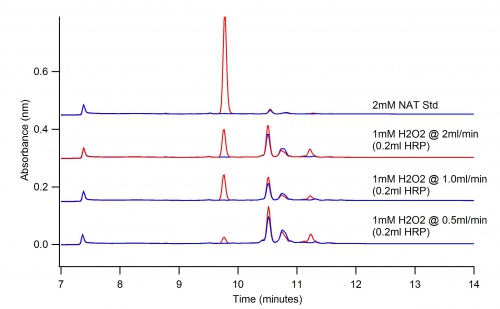
Concentration Test
These graphs depict the difference in concentration of NAT and H2O2. Increasing the concentration will help to obtain more products.
Flash Chromatography
The objective of flash chromatography is to isolate peaks seen in the HPLC. Running flash chromatography allows for the product to be isolated.
The following graphs show the difference between running the flash system under conditions with wavelength at 276 and 300 with 223 and 276. The first graph is the NAT standard ran through the HPLC. The two flash chromatography graphs show the difference in changing the methods of the flash system.
The following graph shows a difference between the flow rates of Flash Figure 2 and Flash Figure 3. Flash figure 3 was ran at a speed of 18ml/min while Flash Figure 3 was ran at 9ml/min.
Analysis of Flash Data: While having the axes at different magnitudes can make this flash data confusing, it is important to understand the purpose of flash, which is separation. When running the flash at a wavelength of 223 as opposed to 276, more of a peak is put into one test tube. The same was true when running the flash at 9ml/min as opposed to 18ml/min. The most favorable combination of flow rate and wavelength was Flash Figure 3, with wavelengths of 223 and 276 and with a flow rate of 9ml/min.
For the Future: The next step moving forward is to use this information from the NAT standard to run a sample through the flash that has been reacted with peroxide and HRP. Then, by isolating these products, they can be then again run through the HPLC to test how pure the isolated samples are. Once isolated samples are acquired, running an H-NMR scan on the isolated and purified products will help to identify exactly what are the products from the oxidation of N-Acetyl L-Tyrosine.
Antioxidants in Reaction
The following graph depicts the oxidation of 2mM NAT by H2O2 with various concentrations of ascorbic acid in pH 5 buffer.
The following is the oxidation of 2mM NAT by H2O2 with various concentrations of reduced GSH in pH 5 buffer.

